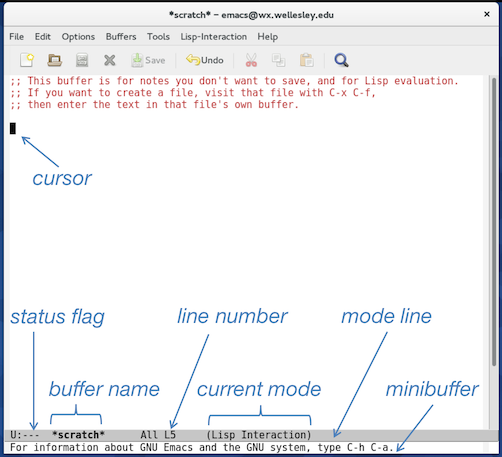

This listing is the behavior of default completion function. You can press Tab again to let Emacs show a list of files and folders in your home folder – mine is not particularly informative, but here it is as an example. Tab is often used as calling "completion" – it is to let Emacs automatically complete what you are trying to type. You will see that c:/Program Files/Emacs is slightly grayed out and ~/ added now in minibuffer. Type ~/ after Find file: c:/Program Files/Emacs like in the imabe below and press Tab. By default, it should be C:\Users\USERNAME\AppData\Roaming.
#How to make a new file in emacs windows
Home folder is defined by your Windows environmental variable and can be customized to your liking. Press C-x C-f(Keep pressing CTRL and press x then f). If the file you specify does not already exist, Emacs tries to create a new one for you.įor now, cancel the Find file dialog and follow the Emacs way. In Emacs, creating a new file uses the same command as opening an existing file. You can also try C-x C-f, and you will see a different "dialogue" Find file: c:/Program Files/Emacs/ appears in minibuffer. You will see a familiar dialog box to locate a file you want to open.

Use the menu bar, and go File > Visit New File. You will see "Quit" displayed in the minibuffer as you can see in the image below. You can cancel calling a command by pressing C-g in the middle of typing a command. You will see later that it is also useful to discover functions that are provided by Emacs for specific packages, like Org Mode, etc.īack to calling a command and canceling it. My recommendation is to keep the menu bar until you are comfortable with key bindings and Emacs in general. If you call the same command again, the menu bar appears again ("Menu Bar mode enabled").

Notice the menu bar on top disappears with the text in minibuffer saying, "Menu Bar mode disabled". RET refers to Return – on Windows, it's Enter. M-x menu-bar-mode or M-x menu-bar-mode RET. Press M-x and type "menu bar mode", and then press Enter you will notice that a space you type is automatically replaced by a hyphen "-". Let's try to hide and show the menu bar as an example – here, you can make the menu bar reappear if you don't see it by default, like when you are using Doom Emacs. This area looks like a "status bar" in fact, it is more than the status and is called "minibuffer" in Emacs. When you call it, your cursor moves to the bottom part of the screen, prompting you to type a command. For example, M-x means you press Alt + X. There is another important key used throughout Emacs: M. You will see "Quit" at the bottom of Emacs (but it's not closing Emacs all together…). This is the keyboard shortcut ("key binding" or "keybinding") assigned to the "Quit" function.Ĭtrl + X, then Ctrl + C (this will be, while you keep pressing Ctrl, press x then c).Ĭall commands, cancel command you are typingĬ-g is to cancel what you are doing. In the menu selection, there is "C-x C-c" next to "Quit". There is a way to make it appear (see next section). If you happen to be using Doom or some other framework, you may not see the menu bar on top many frameworks hide it by default. I recommend to refer to the menu bar until you are really comfortable with Emacs. Use the menu on top of the application window (called "menu bar"), as shown below. If running Emacs also opens a command prompt window at the same time, then you have clicked the wrong file. Make a shortcut so that it's easy to find next time.ĭon't use emacs.exe (there is no harm using it but you'll probably find the extra window distracting). Go to the folder where you installed Emacs (it should be C:\Program Files\Emacs by default and under a folder named \x86_64\bin). If you didn't create a shortcut in Start Menu, don't worry. Open Windows Start Menu, and type "emacs" and run it. And I did not open Emacs again for a while I was traumatized. I don't remember how I managed to close it. I panicked because I didn't know what I was doing. When I first started using Emacs, my first question was "How do I quit this thing?". Knowing you can quit and stop will make you feel more comfortable using Emacs.
#How to make a new file in emacs how to
Let's also see how to cancel a commend you are typing in Emacs. But there is more you can learn about Emacs from quitting. To quit, clicking on the "X" on the top right corner of the window will work, alright. Let's start with opening and quitting Emacs. Use Emacs to write some text (including copy & paste)


 0 kommentar(er)
0 kommentar(er)
